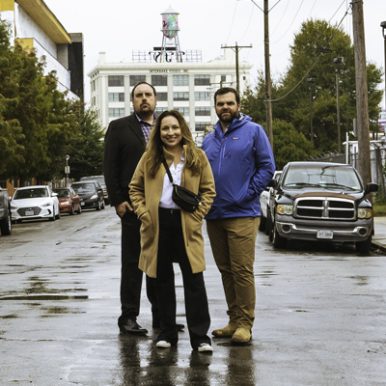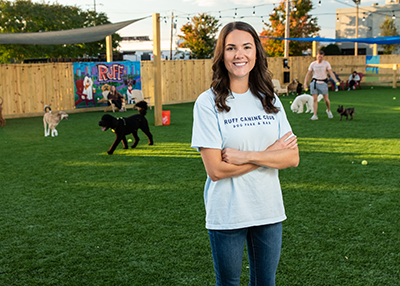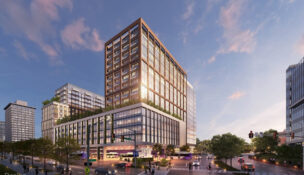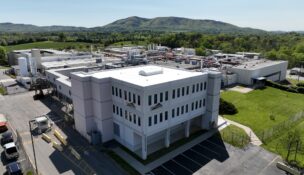Hot property
Richmond has big plans for growing Scott’s Addition area
Ryan McKinnon //November 29, 2021//
Hot property
Richmond has big plans for growing Scott’s Addition area
Ryan McKinnon //November 29, 2021//
Richmond real estate developer Andrew Basham’s company, Spy Rock Real Estate, owns so many properties within Scott’s Addition that local business owners jokingly refer to the neighborhood as “Andrew’s Addition.”
As the area has become Richmond’s hottest neighborhood — literally and figuratively — Basham and his business partners at Spy Rock appear to have been prophetic, foreseeing breweries, apartment complexes and restaurants in an area that was largely a desolate industrial district barely a decade ago.

But some of the investors who bought into Basham’s vision saw him less as Nostradamus and more as Captain Obvious.
During a pitch to a potential investor in 2013, Basham rolled out an aerial map, showing the industrial neighborhood. It was chock-full of buildings eligible for historic preservation tax credits, nestled just north of the Fan and the Museum District, surrounded by interstates and equidistant between downtown and the West End.
The investor “was baffled. He said, ‘I don’t understand why this neighborhood hasn’t been developed yet,’” Basham recalls. “He was right. It’s in the middle of everything.”
‘Greater Scott’s Addition’
Development in the neighborhood, which still has enough of an industrial feel that it contains two strip clubs, is contagious.
The historic core of Scott’s Addition runs north of Broad Street to the train tracks, and west of Arthur Ashe Boulevard until you hit Interstate 195. The term “mixed use” may be an understatement in a neighborhood with apartments, produce distributors, breweries, makerspaces, a fencing club and a boutique bowling alley. It also is home to Movieland at Boulevard Square, one of only two first-run movie theaters in the city.
The explosive growth within this small quadrant has inspired speculation as to how nearby industrial neighborhoods can catch the wave.
Many of the city government’s most ambitious plans revolve around “Greater Scott’s Addition,” which would expand the neighborhood northeast to encompass the area across Hermitage Road all the way to the interstate.
The Richmond 300, an urban planning guide for what city leaders hope Richmond looks like by its 300th birthday in 2037, envisions the area between Arthur Ashe Boulevard and Hermitage Road transforming into an urban playground, with parks, bike paths, mixed-income housing, and entertainment and sports complexes.
Situated between Arthur Ashe Boulevard and Hermitage Road, the Richmond Flying Squirrels’ home baseball stadium, The Diamond, is slated to be torn down in the next four years. City officials are planning a new stadium that the Squirrels will share with Virginia Commonwealth University’s baseball team near the old stadium site that the Squirrels say needs to be ballgame-ready by 2025.
The city has dubbed the 67-acre site encompassing the current baseball field as “the Diamond District,” and city officials have said they plan to release requests for development proposals for the district by the end of 2021.
VCU has been buying up properties on the other side of Hermitage Road from the Diamond District, with plans to build a 40-acre Athletic Village that will include indoor and outdoor tennis courts accessible to the public as part of a major sports practice facility.
In July, Richmond City Council approved a massive rezoning of the area to favor higher density and mixed-use development, the first step toward realizing the Richmond 300 dream for the area.
While plans for Greater Scott’s Addition are dramatic, development in the historic core of the neighborhood has not slowed down. Apartment complexes are constantly under construction, including a 2.28-acre, 350-unit complex with 16,000 square feet of retail space being built by Greystar and Capital Square. The $32.4 million project encompasses an entire city block and is expected to open in late 2022. Brambly Park winery opened in June 2020, adding two acres of green space and an event venue with the neighborhood’s first winery.
Staying on top of the new developments in Scott’s Addition requires setting Google alerts and keeping a sharp eye on the city’s construction permits.
“I can’t even keep track of it,” jokes Trevor Dickerson, president of the Scott’s Addition Boulevard Association.
‘Like 1945 around here’
Scott’s Addition’s history is part of its charm, but some of its historic remnants aren’t so charming.
The historic core of the neighborhood is where visionaries saw potential and started snatching up real estate in the early 2010s.
Part of the allure was that buildings within the core had historic tax credits. The neighborhood was listed as a historic district on the National Register of Historic Places in 2005, in recognition of its pivotal role as a thriving industrial district and railroad hub for much of the 20th century.
The historic tax credit “was a huge boon,” Basham says. “It de-risked financially some of the investments that were being made in the neighborhood.”
The area has proven there is a ravenous appetite for converting early-20th to mid-20th century industrial buildings into hip restaurants or breweries, but it has also proven that 1930s infrastructure doesn’t always gel with modern city life.
Two-lane, one-way streets were ideal for delivery trucks making multiple stops when the neighborhood was primarily industrial, but now these create speeding hazards. Sidewalks, old-growth trees, streetlights and corner trash cans that are the norm in neighborhoods like Church Hill or Carytown are sparse in Scott’s Addition.
The neighborhood’s needs are so acute that the Scott’s Addition Boulevard Association voted “no opposition” to an early proposal to build a casino on the Movieland site, while all the surrounding neighborhoods opposed the location.
That “no opposition” vote was made in part because of promises from the proposed casino operator to invest in area infrastructure, Dickerson said. “They were kind of this hero waiting in the wings,” Dickerson says, allowing that the association was “skeptical of that.”
Richmond voters ultimately rejected a proposed South Side casino in a November referendum, but it illustrates just how badly Scott’s Addition business owners want improvements.
“How did this neighborhood get this far for so many years without basic sidewalks or basic lighting?” asks Sandi Cano, the owner of Turn Cardio Jam Studio. “Basic infrastructure belongs here. Why does it still look like 1945 around here in certain parts? That’s what blows my mind.”
Cano has reason to be upset.

She’s one of the early converts, having opened her gym in the Scott’s Addition neighborhood back in 2015.
She’s been a longtime advocate for greater investment in the neighborhood’s infrastructure, but last year the traffic pattern nearly killed her. Two days before Christmas 2020, Cano was sitting at the stoplight at the intersection of Roseneath Road and Clay Street when a driver traveling more than 60 miles per hour rear-ended her car. The collision propelled her vehicle into the intersection, where she was struck head-on by a pickup truck. Her car was totaled, she suffered a traumatic brain injury and was out of work for months.
“This road has no stop signs,” she says, pointing east on Clay Street, where cars along the two-lane road pick up speed between Arthur Ashe and Roseneath. “That’s why he went so, so fast.”
Dickerson says T-bone accidents are common throughout the neighborhood, with cars trying to cross east-west thoroughfares and pulling in front of oncoming traffic.
The city has tried to alleviate traffic within the neighborhood through Greater Richmond Transit Co.’s Pulse bus route, which runs a 7.6-mile stretch from Rocketts Landing to Willow Lawn, but the young professionals filling Scott’s Addition apartments aren’t big bus riders.
“A lot of people use it, but it’s not solving all our problems,” Dickerson says. “A lot of folks still rely on cars in this town.”
Dickerson and other business owners have tackled some of the infrastructure issues themselves. They are working with developers to get a multiuse path built along old rail lines that could one day connect to bike paths on the other side of Arthur Ashe Boulevard. And they bought trash cans from the city to minimize litter, but they’re now in a dispute with the city over who collects the trash.
But even the most active civic association doesn’t have the resources to build a sidewalk grid or change traffic patterns. The state denied funding for an $8.5 million proposal to convert West Clay Street into a two-way street, which would slow traffic down.
“Long term — if the city doesn’t make the improvements to transportation and safety infrastructure, and the basic things a neighborhood needs like sidewalks, lights and trees, that will ultimately be problematic,” Basham says.
Need for green
As the neighborhood enters its latest phase of redevelopment, the need for green space is evident.
The civic association has created two small and unofficial “pocket parks” with benches, grass, picnic tables and pervious pavers. The Richmond 300 plan calls for a major urban park in the coming decade, stretching from behind the Science Museum of Virginia all the way north to the current site of The Diamond.
But until that happens, the concrete jungle vibe of Scott’s Addition is particularly evident on hot summer days.
A 2017 study on the city’s temperature found that places like The Diamond or the patio at Scott’s Addition bowling alley River City Roll could be as much as 16 degrees hotter than other parts of the city during the hottest part of the day, and many parts of Scott’s Addition stayed at elevated temperatures well into the evening.
“It’s the hottest neighborhood in Richmond — literally,” Dickerson says.
The heat is both an environmental problem and a marketing problem. The neighborhood’s developers target an extremely dog-friendly demographic.
Most of the neighborhood’s residents are young people without children or empty-nest retirees — two groups that love their dogs. But a lack of shade or grass and an abundance of hard, dark surfaces has dogs hopping from paw-to-paw as they pad along on sweltering sidewalks in July and August.
That’s why Natalie Moore opted to open Ruff Canine Club, the city’s first dog park bar, in the industrial area just north of Scott’s Addition’s historic core in October. The club is on Ellen Road, next to biotech firm Grenova Inc. and across the street from Siewers Lumber & Millwork.
In an area where dogs can be seen wearing doggy shoes to protect their pads from the pavement on a warm day, Ruff Canine Club has nearly an acre of grass for dog romping, along with drinks, food and Wi-Fi.
“I wanted to be in an area that had a lot of apartments and not a lot of green space,” Moore says. “This was definitely the most ideal spot.”
As more and more entrepreneurs like Moore are drawn to Scott’s Addition and its surrounding areas, commercial and residential rents are on the rise, and some of the original business owners are wondering whether they can afford to continue living and working in the city’s hottest neighborhood.
“Scott’s Addition is probably one of the most desirable commercial areas in Richmond right now,” Basham says. “When you create that environment, rents go up. It’s a victim of its own success in that sense.”
l
















